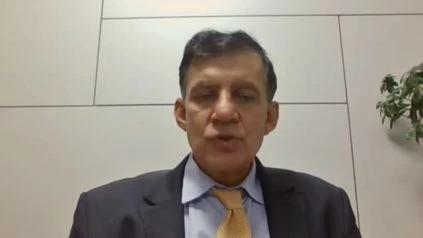Meletios A. Dimopoulos, MD – Professor, and Chairman of the Department of Clinical Therapeutics National and Kapodistrian University of Athens School of Medicine, Athens, Greece discusses ASH 2020 Abstract Primary results from the APOLLO study of Darzalex Faspro (subcutaneous daratumumab), in combo with Pd, in patients with at least one prior line of therapy (Abstract #412).
Introducing
The quality of treatment (SOC) for RRMM is immunomodulatory medication (IMiD)-based regimens. Daratumumab (DARA) is a mAb targeting CD38 approved for the treatment of RRMM pts. DARA’s subcutaneous (SC) formulation has a safety profile close to that of intravenous DARA, with a statistically significant decrease in infusion-related reaction (IRR) rates and a slightly shorter time of administration of 5 minutes. In the US, EU, Canada, and Korea, DARA SC is licensed for use.
In the DARA plus IMiD pomalidomide phase 1b analysis, D-Pd induced deep responses and was well tolerated in pts with extremely pretreated RRMM, including those with previous treatment with lenalidomide (len). For RRMM pts with about 2 previous therapy lines, including len and a proteasome inhibitor, D-Pd is approved in the US for (PI).
APOLLO (NCT03180736) is a phase 3 study performed in collaboration between researchers from the European Myeloma Network and Janssen to evaluate DARA SC plus Pd vs Pd alone in RRMM pts that had received around 1 prior therapy line, including len and PI. We are presenting the APOLLO primary study.
Methodology
Qualified pts had RRMM in this open-label, multicenter study and received around 1 prior therapy line including len and a PI, responded to prior therapy and improved on or after their last regimen; pts with only 1 prior therapy line (1PL) were needed to be refractory to len. Prior treatment with anti-CD38 or pomalidomide was not required. Pts were randomized to Pd ± DARA SC by 1:1. Stratification was based on the level of disease (I, II, III) of the International Staging System (ISS) and the number of prior therapy lines (1, 2-3, ⇠4).
The 28-day care periods of all pts were obtained (C). P: 4 mg (PO) QD on 1-21 days; d: 40 mg (PO) on 1, 8, 15 and 22 days (20 mg for 75-year-old pts). For D-Pd pts, QW for C 1-2, Q2W for C 3-6, and subsequently Q4W were given to DARA. Pts received DARA IV 16 mg/kg prior to protocol amendment (n=7); all pts received DARA SC 1,800 mg co-formulated with recombinant human hyaluronidase PH20 (rHuPH20; ENHANZE® drug delivery technology, Halozyme, Inc.) after protocol amendment. Up until disease progression or unacceptable toxicity, all pts were treated. PFS was the main endpoint. Total response rate, rates of very good partial response or better and full response or better, MRD-negativity rate, overall survival (OS), and protection were major secondary endpoints.
Outcomes
A total of 304 pts were randomized from 12 European countries (151 D-Pd; 153 Pd). The median (range) age was 67 (35-90) years, and ISS stage I/II/III was 45 percent /33 percent /22 percent pts. 35% had an elevated cytogenetic risk (presence of del17p, t[14;16], or t[4;14]). 1PL (median [range] prior therapy lines = 2 [1-5]) was obtained by 11 percent of pts. 79.6% of pts were len-refractory, 48.0% of pts were PI-refractory, and 42.4% of pts were both refractory. The median treatment period was 11.5 months for D-Pd vs. 6.6 months for Pd.
After 190 PFS cases, the primary analysis was performed. The primary outcome of improved PFS was reached by the study; the hazard ratio (HR) was 0.63 (95% CI, 0.47-0.85; P=0.0018), reflecting a 37% reduction in the risk of progression or death in D-Pd treated pts. For the D-Pd vs. Pd weapons, the median PFS was 12.4 months versus 6.9 months, respectively. 99 pts (33 percent) died with a median follow-up of 16.9 months; HR for OS was 0.91 (95 percent CI, 0.61-1.35); survival evidence is immature and follow-up is continuing. CR rates were 24.5 percent vs 3.9 percent for D-Pd vs Pd; VGPR rates were 51.0 percent vs 19.6 percent. Neutropenia (68 percent vs 51 percent), leukopenia (17 percent vs 5 percent), lymphopenia (12 percent vs 3 percent), febrile neutropenia (9 percent vs 3 percent), and pneumonia were the most common grade 3/4 adverse events with a >5 percent difference between D-Pd vs Pd (13 percent vs 7 percent ). With DARA SC, the rate of IRRs was poor (6%, all grade 1/2), and 2% of pts had local injection-site reactions (all grade 1). The median injection time was 5 mins. The rates of discontinuation of study care due to TEAEs for D-Pd vs. Pdd were close (2 percent vs 3 percent ). The safety profile of D-Pd complies with the established DARA SC and Pd profiles.
Completion
D-Pd significantly decreased the risk of progression or death by 37 percent in pts with RRMM who had obtained around 1 prior line of therapy vs Pd alone in this phase 3 study examining DARA SC plus Pd. There were no new safety issues observed. The IRR rate was very low and the length of administration was limited, thereby increasing comfort for pts and reducing the burden of treatment. Collectively, these data illustrate that D-Pd is an efficient and easy treatment for RRMM pts that have undergone around 1 prior treatment, like len and a PI.

